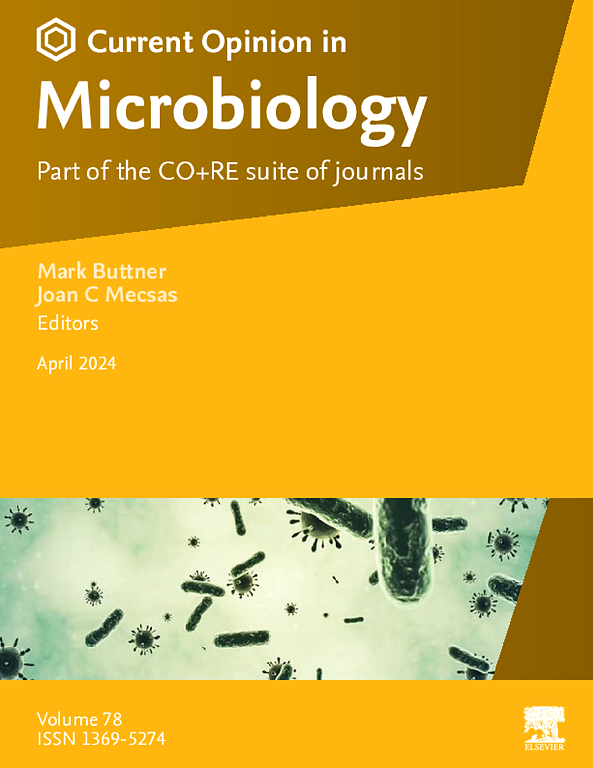Decoding the epigenetic blueprint behind Toxoplasma (pre)sexual commitment and chronic persistence
IF 7.5
2区 生物学
Q1 MICROBIOLOGY
引用次数: 0
Abstract
Toxoplasma gondii, a widespread apicomplexan parasite, navigates a complex life cycle in which it switches back and forth between tachyzoites and bradyzoites to balance acute infection and persistence while also undergoing an often-overlooked one-way commitment to the sexual stage. Emerging evidence suggests that Toxoplasma’s developmental trajectories are orchestrated by an interconnected network of transcriptional switches and chromatin remodeling mechanisms, acting in concert to ensure robust stage transitions. This review outlines an updated epigenetic framework for stage transitions and highlights the functional synergy between an Imitation SWItch family chromatin remodeler and the MORC/HDAC3 repressor complex, which together modulate chromatin accessibility to maintain or shift developmental states. We also spotlight recent findings, showing that simultaneous depletion of AP2XII-1 and AP2XI-2 transcription factors reactivates the presexual program in vitro, eliminating the need for cat hosts and allowing ethical, scalable exploration of sexual stages. Strikingly, the knockdown of these transcription factors also reveals a previously unrecognized hybrid zoite co-expressing bradyzoite and merozoite markers, suggesting a transitional state that defies classical stage definition. This hybrid form, as well as more recent data on bradyzoite development, support a new model in which T. gondii development unfolds along a continuum of epigenetically primed states rather than a rigid sequence of binary fate decisions. These findings provide a powerful conceptual and experimental framework for dissecting parasite transmission and persistence and have far-reaching implications for the biology of other parasites in the phylum.
破译弓形虫(前)性承诺和慢性持久性背后的表观遗传蓝图
刚地弓形虫是一种分布广泛的顶复体寄生虫,它在复杂的生命周期中,在速殖体和慢殖体之间来回切换,以平衡急性感染和持久性,同时也经历了一个经常被忽视的单向性阶段。新出现的证据表明,弓形虫的发育轨迹是由一个相互关联的转录开关网络和染色质重塑机制精心策划的,它们协同作用,确保了稳健的阶段过渡。这篇综述概述了阶段转变的最新表观遗传学框架,并强调了模仿开关家族染色质重塑子和MORC/HDAC3抑制子复合物之间的功能协同作用,它们共同调节染色质可及性以维持或改变发育状态。我们还关注了最近的研究结果,表明AP2XII-1和ap2xii -2转录因子的同时耗尽在体外重新激活了性前程序,从而消除了对猫宿主的需求,并允许道德的、可扩展的性阶段探索。引人注目的是,这些转录因子的敲除也揭示了一种以前未被识别的杂交子胚共表达慢殖子胚和裂殖子胚标记物,表明这是一种与经典阶段定义不同的过渡状态。这种杂交形式,以及最近关于慢殖子发育的数据,支持了一种新的模型,即弓形虫的发育是沿着一个连续的表观遗传启动状态展开的,而不是一个严格的二元命运决定序列。这些发现为剖析寄生虫的传播和持久性提供了强有力的概念和实验框架,并对门中其他寄生虫的生物学具有深远的意义。
本文章由计算机程序翻译,如有差异,请以英文原文为准。
求助全文
约1分钟内获得全文
求助全文
来源期刊

Current opinion in microbiology
生物-微生物学
CiteScore
10.00
自引率
0.00%
发文量
114
审稿时长
6-12 weeks
期刊介绍:
Current Opinion in Microbiology is a systematic review journal that aims to provide specialists with a unique and educational platform to keep up-to-date with the expanding volume of information published in the field of microbiology. It consists of 6 issues per year covering the following 11 sections, each of which is reviewed once a year:
Host-microbe interactions: bacteria
Cell regulation
Environmental microbiology
Host-microbe interactions: fungi/parasites/viruses
Antimicrobials
Microbial systems biology
Growth and development: eukaryotes/prokaryotes
 求助内容:
求助内容: 应助结果提醒方式:
应助结果提醒方式:


